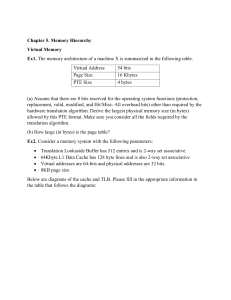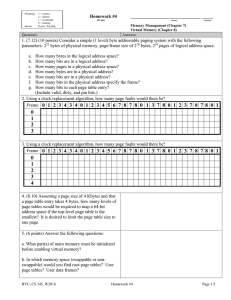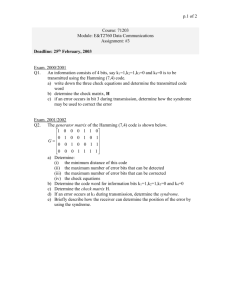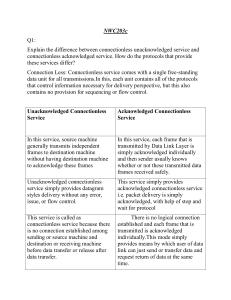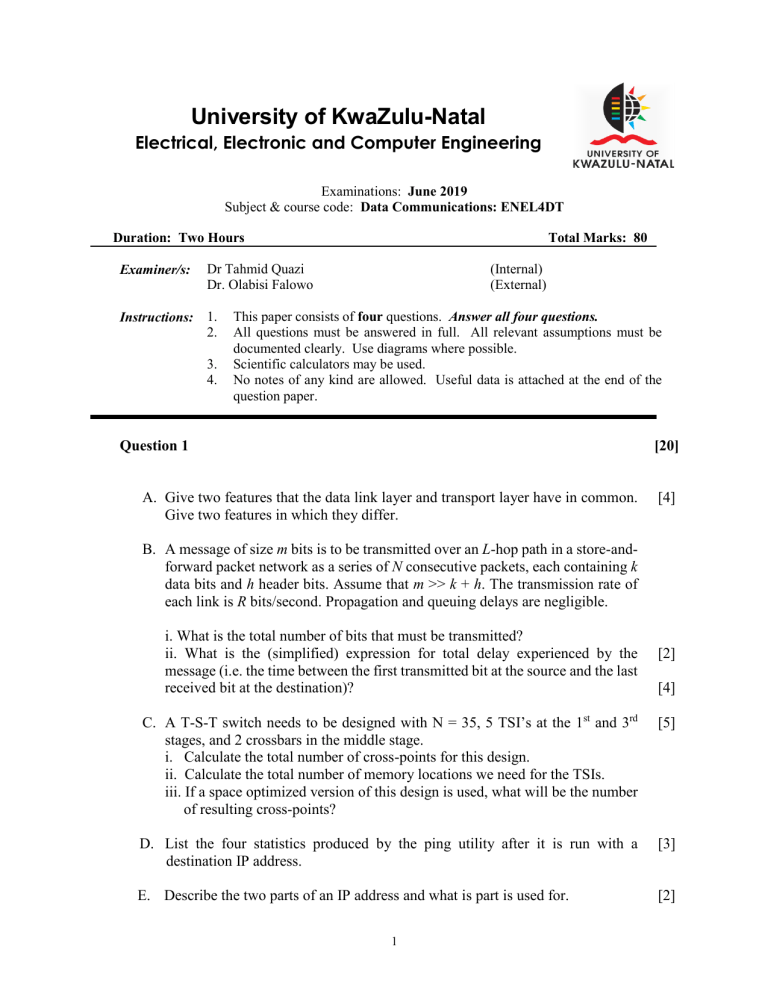
University of KwaZulu-Natal Electrical, Electronic and Computer Engineering Examinations: June 2019 Subject & course code: Data Communications: ENEL4DT Duration: Two Hours Examiner/s: Total Marks: 80 Dr Tahmid Quazi Dr. Olabisi Falowo Instructions: 1. 2. 3. 4. (Internal) (External) This paper consists of four questions. Answer all four questions. All questions must be answered in full. All relevant assumptions must be documented clearly. Use diagrams where possible. Scientific calculators may be used. No notes of any kind are allowed. Useful data is attached at the end of the question paper. Question 1 [20] A. Give two features that the data link layer and transport layer have in common. Give two features in which they differ. [4] B. A message of size m bits is to be transmitted over an L-hop path in a store-andforward packet network as a series of N consecutive packets, each containing k data bits and h header bits. Assume that m >> k + h. The transmission rate of each link is R bits/second. Propagation and queuing delays are negligible. i. What is the total number of bits that must be transmitted? ii. What is the (simplified) expression for total delay experienced by the message (i.e. the time between the first transmitted bit at the source and the last received bit at the destination)? [2] [4] C. A T-S-T switch needs to be designed with N = 35, 5 TSI’s at the 1st and 3rd stages, and 2 crossbars in the middle stage. i. Calculate the total number of cross-points for this design. ii. Calculate the total number of memory locations we need for the TSIs. iii. If a space optimized version of this design is used, what will be the number of resulting cross-points? [5] D. List the four statistics produced by the ping utility after it is run with a destination IP address. [3] E. Describe the two parts of an IP address and what is part is used for. [2] 1 Question 2 [20] A. If the bit rate of the STS-3 SONET signal is 155.52 Mbps, what is the number [2] of voice channels by it? B. Assume that a network Access Multiplexer has to multiplex 10 subscribers connected at c bps and subscriber is active 1/3 of the time. Show by means of calculations what the minimum over-subscription ratio should be to make the overflow probability less than 1%. [7] C. Consider the network in Figure 1. Use the Bellman-Ford algorithm to find the set of shortest paths from all nodes to node 3. [5] 2 1 5 3 3 4 1 2 1 2 6 3 5 4 2 Figure 1 D. Suppose that a 13 kbps encoded voice signal is packetized into a constant bit rate ATM cell stream. Assume that each cell holds 48 bytes of speech and has a 5 byte header. i. What is the interval between production of full cells? ii. How long does it take to transmit a cell at 51.84 Mbps? iii. How many cells could be transmitted in this system between consecutive voice cells? Question 3 [6] [20] A. Consider an application layer protocol that uses the Go-Back-N ARQ protocol. Suppose that the frames are 1250 bytes long including 25 bytes of overhead. Also assume that ACK frames are 25 bytes long. Calculate the efficiency of the ARQ system that transmits at a rate of R = 1 Mbps and with a reaction time, 2(tprop + tproc) = 100ms, and a bit error rate of 10-5. Let the sliding window size be 11. [6] B. Assume that a 1-Mbit message is being transmitted over the 2 hop network setup using 10 packets of size 100-Kbits. How many bits will be transmitted to deliver the message? C. Suppose that a low-pass communications system has a 5 MHz bandwidth. i. What bit rate is attainable using 8-level pulses? [4] 2 [5] ii. What is the Shannon capacity of this channel if the SNR is 20 dB? D. Find the CRC codeword corresponding to information bits 110110 if 𝑔𝑔(𝑥𝑥) = 𝑥𝑥 3 + 𝑥𝑥 2 + 1 is used as the generating polynomial. Question 4 [5] [20] A. Describe by means of a timing diagram the ALOHA MAC algorithm. Show, using the diagram, the derivation of the algorithm’s maximum throughput. Clearly define all the variables used. [8] B. Derive the formula for the efficiency of CSMA/CD knowing that the maximum number of attempts made before the 1st successful transmission is the exponential constant 𝑒𝑒 (𝑒𝑒 = 2.7183). Clearly show your formulation, define your variables and show each step of the derivation. [6] C. Assume M terminals are attached by a dedicated pair of lines to a hub in a star topology. The distance from each terminal to the hub is 𝑑𝑑 meters, the speed of the transmission lines is 𝑅𝑅 bits/second, all frames are of length 20 KiB, and the 8 signal propagates on the line at a speed of 2.3 x10 meters/second. Numerically compare the maximum network throughput achievable when the hub is implementing: Slotted ALOHA; CSMA/CD, for the 𝑑𝑑 = 50 meters and 𝑅𝑅 = 4 𝑀𝑀𝑀𝑀𝑀𝑀𝑀𝑀. DATASHEET 𝐷𝐷 = 𝐿𝐿𝐿𝐿 + 𝐿𝐿𝐿𝐿 + (𝑘𝑘 − 1)𝑃𝑃 N r k r N−k Qn = � � � �1 − � c c k=n+1 𝜂𝜂𝐺𝐺𝐺𝐺𝐺𝐺 = �1 − 𝑃𝑃𝑓𝑓 � S = 𝐺𝐺𝑒𝑒 −𝐺𝐺 1 1− 𝑛𝑛0 𝑛𝑛𝑓𝑓 �1 + (𝑊𝑊𝑠𝑠 − 1)𝑃𝑃𝑓𝑓 � 𝑡𝑡𝑝𝑝 𝜌𝜌 = 1+6.44𝑎𝑎 where 𝑎𝑎 = 𝐿𝐿/𝑅𝑅 3 [6]
